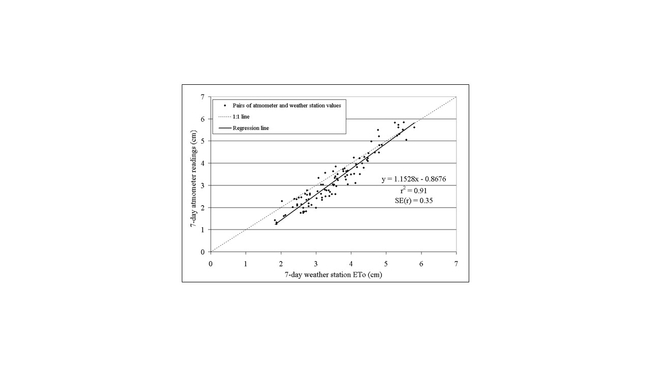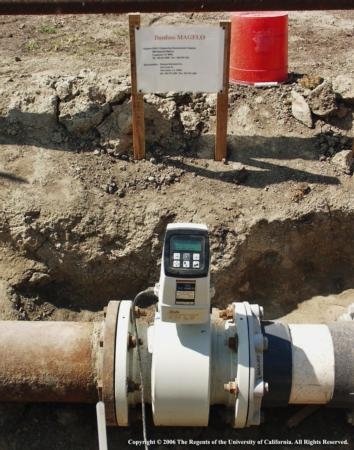
Posts Tagged: scheduling
Low-Flow Irrigation Scheduling
How to irrigate is probably the most common question in irrigated agriculture, even with 10,000 years of cultivation knowledge to guide us. The complexities of irrigation and the unique situation for each grower makes this question so difficult. Not enough water, and plants have diminished growth or the propensity for disease and disorder 1. Too much water leads to root disease and nutrient problems 2. So, it can't be too much or too little, but just right. There are times when citrus can handle a little more water stress than other times, which can lead to water savings 3, especially in a drought year or in areas where water costs are crucial. Salinity further compounds the question of irrigation where striking a balance determines the health of your tree. Staying in tune with your orchard and using appropriate methods to measure water need, water use, environmental water demand, and soil water-holding capacity will help inform irrigation management decisions.
There are all kinds of ways of estimating tree water need 4 , a valuable piece of information for irrigation decision making. An inexpensive and often overlooked method of estimating tree water requirements is grower observation in the orchard to assess leaf color, leaf size, the look of the leaves, and canopy fullness. Pure observation and knowledge of your trees yields a lot of valuable information regarding irrigation management. Beyond observation, a direct measure of the tree with a porometer, pressure gauge (bomb), sap flow meter, dendrometer or other device gives an absolute or relative number of tree performance. Technological advances, such as telemetry and imaging with drones or satellites, holds promise, but are still being perfected for general irrigation use. In general, technological devices yield informative data, but tend to be expensive, delicate, and require manual monitoring to account for tree-to-tree variation in the orchard.
Soil moisture sensors can be an effective method of evaluating water use by the tree. The most basic way to measure soil moisture is with a human powered shovel or soil tube 5. While it requires an operator who knows what they are doing, the technique is easily learned and repeatable. A human and shovel can move around an orchard checking out different suspicious spots that are not easily done with fixed-in-place sensors. Installation of soil moisture sensors systems range in cost and capabilities, yet provide specific data on water use. Integrating certain systems into communication relay systems allow for the monitoring of multiple sites at once. Some sensors can measure soil salinity, as well as soil moisture, to give a sense of whether the water in the soil will be useable by the tree. If soil moisture sensors are used, correct placement of where roots are taking up water is imperative to get an accurate assessment of water uptake. Overall, it is critical to keep the entire orchard in mind and understand that fixed sensors only take a specific location's reading.
Another great technique to inform irrigation scheduling is an estimate of the demand that drives water use. An evapotranspiration estimate either by CIMIS, a private weather station with ET-calculation or atmometer gives not only an amount to apply but also when to apply that amount based on the water holding capacity of the soil and the rooting depth of the crop. Soil moisture holding volume can be complicated, but can be estimated from the NRCS table in the previous paragraph5 or from tables in the Web Soil Survey 7.
Simply running an irrigation system for a specific amount of time and probing for depth of water penetration and extent of wetted area is the best way to get an estimate of soil moisture holding capacity. This knowledge is needed in order to decide whether the active rooting volume is getting wetted sufficiently or too much is being applied. Emitters are rated by gallons per hour, but that 1 gph, 5 gph, 20 gph emitter output might differ according to water pressure that can vary over an irrigation period. On the flip side, monitoring soil moisture depletion over time can give an approximation of how depletion compares to ET estimates. Soil moisture depletion can be measured by soil moisture sensors or by shovel and feel. This estimate of applied water compared to output and ET only needs to be done once at a given growth stage of the orchard. If the orchards is young, it will need to be done each year as the trees fill out. An estimate of canopy growth can also be used to better approximate young orchard ET.
All of these methods suppose that a grower has the capability to irrigate when, where and for how long they need to. If water delivery is on a fixed schedule and the amount of water can be controlled it is valuable to understand specific water needs. Knowing the rated applied amount of an emitter is important, but that amount shouldn't be assumed, especially considering natural wear and tear, damage from harvest, poor filtration, clogging, or damage by wildlife. Maintenance to insure good distribution uniformity is critical to the operation and the correct application of water to trees and for the maintenance of tree health. Low-pressure systems are wonderful but they should be evaluated on a yearly basis and tuned up in preparation for every irrigation season. Many growing areas have mobile irrigation labs that will evaluate system performance and make recommendations for improvement.
All said, knowing the orchard and evaluating tree health will inform irrigation management decisions. Applying technology where technology is appropriate will help. Using it to help advise irrigation decisions is valuable, but new tools will not always be the answer.
It's important to know what is being applied.
Trust but verify.
Drought Tips & Video: https://www.youtube.com/watch?v=LKSQRuHAnYA ; https://anrcatalog.ucanr.edu/pdf/8549.pdf
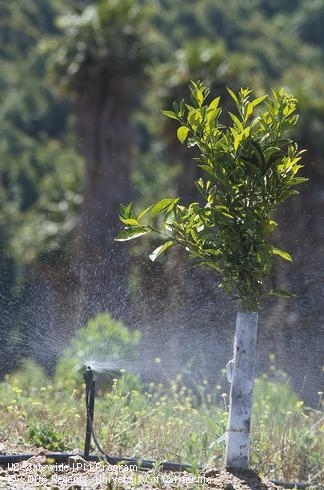
irrigATING CITRUS
Irrigating with an Atmometer?
Say what? Atmosphere meters can be used to assess irrigation requirement. Here's a great little report from Mark Battany, our advisor in Santa Barbara and San Luis Obispo Counties.
ATMOMETERS FOR IRRIGATION MANAGEMENT
- Author: Mark Battany
Efficient and precise irrigation management is becoming increasingly important inCaliforniaagriculture, both for maximizing crop quality and for conserving water. The most advanced irrigation scheduling strategy is based on local measurements of reference evapotranspiration (ETo), which is converted to crop evapotranspiration (ETc) with an appropriate crop coefficient (kc).
To be able to use this method, an irrigation manager needs to have locally accurate ETo values throughout the growing season. However, the highly variable microclimates that characterize many farming areas often make it difficult to use data from distant weather stations; therefore an accurate local measurement may often be preferable to relying on a regional value.
One inexpensive option for measuring ETo locally is to use a simple atmometer. Atmometers are water-filled devices, in which the actual evaporation of water is measured over time. In their simplest form, the atmometer is outfitted with a graduated sight glass on the water supply tank which allows the user to easily measure the evaporation that occurred over a given period. In practice, this type of atmometer is most suited for making readings at multiple day intervals, for example once per week, or on days when irrigation is applied.
The performance of atmometers versus more expensive weather stations was evaluated on the CentralCoastin 2003. In this study, atmometers were placed adjacent to seven weather stations throughout the area, and weekly values for both methods were compared. The results indicate that the atmometers and weather stations have very comparable ETo readings, with the atmometers indicating somewhat lower ETo values under conditions of lower evapotranspiration.
Like any technique, using atmometers has advantages and disadvantages. Advantages include their very low cost and ease of operation, with no computer or power required. Disadvantages include the potential for damage by freezing weather, the need to refill the water supply (every three to six weeks), and the need to read the gauge manually. Also, if they are installed in a large open area, birds may tend to perch on the evaporating surface and foul it with their droppings; for this reason several wires are installed on top of the device to discourage birds from perching there. In general, atmometers function quite reliably with few problems.
Converting atmometer ETo readings to the amount of irrigation run time required to replenish the soil moisture lost to evapotranspiration is fairly straightforward. A relatively simple example for a sprinkler-irrigated field is presented below in Table 1.
|
Table 1. Example conversion of ETo to irrigation run times for a sprinkler irrigated field |
||
|
|
|
|
|
A. Measured atmometer ETo for one week |
2 |
inches |
|
B. Crop coefficient (kc) |
0.8 |
|
|
C. Calculated ETc for the week (=AxB) |
1.6 |
inches |
|
D. Sprinkler application rate |
0.13 |
in/hr |
|
E. Hours of irrigation required (=C/D) |
12.3 |
hours |
(Note: To convert Gallons to Inches: Gallons ÷ Area (square feet) ÷ 0.6234 = Inches. To convert Inches to Gallons: Inches * Area (square feet) ÷ 1.604 = Gallons)
Regression table showing relationshiop between CIMIS weather station and atmometer
Atmometer in the field

atmometer grapes
Water and Nutrient Management in Avocado and Citrus
Recent talks by UC's new irrigation engineers can help shed light on irrigation improvements that also apply to plant health and better orchard management. The Pourreza talk has implications for identifying HLB infected citrus trees, as well as trees in general stress. The Spann presentation shows how avocado growers will be able to adjust fertilizer applications to their orchards. These talks are posted on the California Avocado Society website.

avocado irrigation
Soil Moisture Sensor Selection is Confusing
So, every few weeks the question comes up of whether to install soil moisture meters which leads to the question of which to buy and install or have installed. And then come the questions of what do the readings mean and why aren't the readings consistent. Or maybe this question arrives after the grower has installed the sensors or system and the values don't conform to a known or knowable pattern.
The first question to the grower is why they want to install soil moisture sensors or a system. Everyone has a different answer which I've always found interesting. Usually it boils down to having more or better information, although it's hard to beat a good old soil auger. Which takes time and labor.
So once that is cleared up, it comes down to what area they want to monitor. Is it an acre, 10 acres, 50 acres, 100 acres, 200 acres, 1,000 etc.? What are the different irrigation blocks, soil types, aspects? How complex is the area that is to be monitored? Do they need one monitoring site or many? Can the information be gathered in the field, or does it need to be accessed from a distance? Linked by hardwire, infrared, cell phone, wifi, satellite, etc.?
Then the question is does the grower do the installation or is it done by a company? And then whatever the case is, who maintains the system and for that matter, who maintains the information? What software is used and who interprets it?
And what sensors are being used: tension, electrical resistance, conductance, capacitance, electromagnetic…….? The list seems to go on and there are no models and brands coming out on a regular basis. And how reliable are the sensors? What's their lifespan? And what are they measuring and in what units? How affected are the readings by salinity and what soil volume are they measuring? And how important is their placement?
This last point is so often overlooked. The sensor needs to be in the active root zone where water is being taken up. Not where it's convenient to read, not where the plants cant use the water. Placement is so often overlooked.
And then how much do you want to spend? $100 per installation, $1000? With a monthly or yearly maintenance fee or none? Who responds when there are problems?
Wow, so yeah, there are lots of questions. Here's a chart that might help categorize some of the questions:
|
Method |
Cost |
Ease of use |
Accuracy |
Reliability |
Salt-affected |
Stationary |
|
Gypsum block |
L |
H |
H |
H |
L |
YES |
|
Tensiometer |
L |
M |
H |
M |
L |
YES |
|
Portable tensiometer |
M |
M |
H |
M |
L |
NO |
|
Solid-state tensiometer |
M |
H |
H |
H |
L |
YES |
|
Time domain reflectometer |
H |
M |
H |
H |
M |
BOTH |
|
Neutron probe |
H |
L |
H |
H |
L |
YES |
|
Feel (soil probe) |
L |
H |
H |
H |
L |
NO |
|
Gravimetric (oven) |
L |
M |
H |
H |
L |
NO |
|
Conductance |
L |
H |
M |
M |
H |
BOTH |
|
Capacitance |
M |
H |
M |
H |
M |
BOTH |
H, high; M, medium; L, low
And the good Almond Doctor might help some more:
http://thealmonddoctor.com/2015/07/10/soil-moisture-sensing-systems/
And maybe some of these publications can help sort out what questions to ask
http://calag.ucanr.edu/Archive/?article=ca.v054n03p38
http://calag.ucanr.edu/Archive/?article=ca.v054n03p47
http://anrcatalog.ucanr.edu/Details.aspx?itemNo=21635
Khaled Bali, our Irrigation Specialist at Kearney Research and Education Center near Fresno, is part of a group in the process of evaluating different types and models of soil moisture sensors. He should have a publication that can more accurately sort through the many sensor choices that are available at this time. But in time, there should be more models on the market and new update will be necessary.
The question, though, is to ask yourself how irrigation is being done and how it can be improved. The basics of design, maintenance, distribution uniformity and how scheduling is being currently done – when and how much to apply. Definitely, soil moisture sensors can help, but you gotta know how to use them and maintain them, just like the whole irrigation system.
A grower who uses tensiometers told me that people think of soil sensors as though they were reading a book. Something cut and dried. A simple plot line that you follow. Irrigation is not a book. There are many other subplots to irrigation than just reading the digital face. Looking at the weather, evapotranspiration, the tree, how fast the moisture is depleted, how deep the moisture is being pulled from all contribute to the "sensors" used to irrigate. Use them all. Even though this grower has irrigators on 250 acres of trees, he also checks the orchard tensiometers at least once a week on his own to confirm all of his senses.
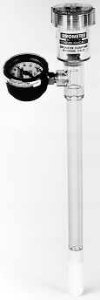
tensiometer2
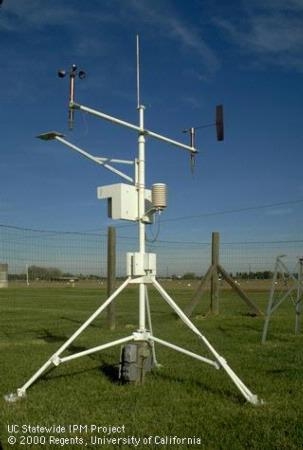
cimis
Flowmeters? You Need One.
At a recent CA Avocado Society meeting there was a discussion about bout flowmeters and their selection. Flowmeters measure the volume of water moving through a full-flowing closed pipe and as such are one of the key components of an irrigation system whether drip, microsprinkler or full pressure systems. They are essential for managing irrigation efficiently and for monitoring the performance of the irrigation system. Managing irrigation efficiently requires: (1) knowing how much water the crop has used since the last irrigation (irrigation schedu7ling); and (2) operating the irrigation system to apply only the amount of water desired. A flowmeter gives the grower the information needed to apply only the amount of water required.
A critically overlooked benefit of a flowmeter is that it makes it possible to identify changes in flowrate during the season (measured at the same pressure), which may indicate problems such as clogging of emitters or filters, leaks in the system or problems with the pump or well.
There are several types of flowmeters and each has their pluses and minuses. Propeller meters are the most commonly used, but can pose two potential difficulties: debris in the water and a small loss of pressure which can be a problem with low flow systems. Alternatives are magnetic meters, ultrasonic, turbine and venture meters. Proper selection is based on pipe size, range of flow and pressure loss. But as with everything it depends on proper installation and maintenance.
Attached is a nice little overview by Larry Schwankl on how to choose a flowmeter for your situation.
flow meters

